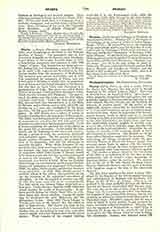

Pforta, a former Cistercian monastery (1137-1540), near Naumburg on the Saale in the Prussian province of Saxony. The monastery was at first situated in Schmolln on the Sprotta, near Altenburg. Count Bruno of Pleissengau founded there, in 1127, a Benedictine monastery and endowed it with 1100 “hides” of land. This foundation not being successful, Bishop Udo I of Naumburg, a relative of Bruno, on April 23, 1132, replaced the Benedictines by Cistercian monks from the monastery of Walkenried. The situation here proved undesirable, and in 1137 Udo transferred the monastery to Pforta, and conferred upon it 50 hides of arable land, an important tract of forest, and two farms belonging to the diocese. For this fact we have Udo’s own statement in a proclamation of 1140. The place was called Pforta (Porta) on account of its location in the narrow valley which was the entrance into Thuringia. The patroness of the abbey was Our Lady, and the first abbot, Adalbert, 1132-1152. Under the third abbot, Adelold, two convents were founded from it, in the Mark of Meissen and in Silesia, and in 1163, Alt-Celle and Leubus (q.v.) were also established in the latter province. At this period the monks numbered about eighty. In 1205 Pforta sent a colony of monks to Livonia, founding there the monastery of Dunamunde. The abbey was distinguished for its excellent system of management, and after the first 140 years of its existence its possessions had increased tenfold. Little is known regarding the spiritual life of the abbey, as the monks left no chronicles. At the end of the thirteenth and the beginning of the fourteenth century, though a period of strife, the monastery flourished with redoubled vigor. The last quarter of the fourteenth century witnessed, however, the gradual decline of its prosperity, and also the relaxation of monastic discipline. When Abbot Johannes IV was elected in 1515, there were forty-two monks and seven lay brothers who later revolted against the abbot; an inspection which Duke George of Saxony caused to be made revealed the fact that morality had ceased to exist in the monastery. The last Abbot, Peter Schederich, was elected in 1533. When the Catholic Duke George was succeeded by his Protestant brother Henry, the monastery was suppressed. (November 9, 1540), the abbot, eleven monks, and four lay brothers being pensioned. In 1543, Duke Moritz opened a national school in the abbey, appropriating for its use the revenues of the suppressed monastery of Memleben. At first the number of scholars was 100; in 1563 fifty more were able to be accommodated. The first rector was Johann Gigas, renowned as a lyric poet. Under Justinus Bertuch (1601-1626) the school attained the zenith of its prosperity. It suffered greatly during the Thirty Years’ War, in 1643, there being only eleven scholars. Among its pupils may be mentioned the poet, Klopstock, and the philosopher, Fichte. Since 1815 Pforta belongs to Prussia, and even at the present day the school is held in high esteem. The church was built in the thirteenth century; it is a cross-vaulted, colonnaded basilica with an extraordinarily long nave, a peculiar western facade, and a late Romanesque double-naved cloister. What remains of the original building (1137-40) is in the Romanesque style, while the restoration (1251-1268) belongs to the early Gothic.
KLEMENS LÖFFLER

